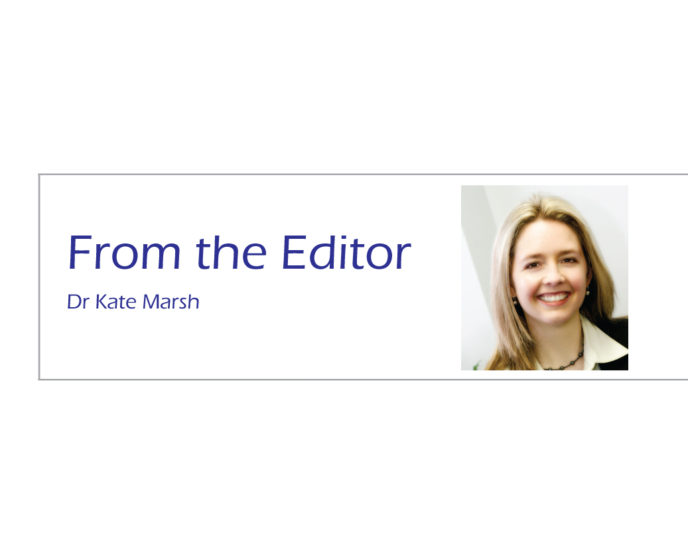Editors Column

Introduction
The 2019 Australasian Diabetes Congress has come and gone, and, once again, had plenty to offer diabetes educators. I’m sure that all who attended came away with plenty of new information and ideas.
Whether or not you were able to attend, we hope you enjoy our annual conference-themed edition of the ADE, aimed at highlighting some of the key presentations from the conference that will be of interest to ADEA members.
These articles are only a taste of what was on offer at the conference and are just an example of the fantastic work being done within our profession.
Rosyln Muirhead and Professor Jennie Brand- Miller from the University of Sydney and the PREVIEW Study Australia discuss some of the lessons learnt from the PREVIEW study group sessions and using the PREMIT (PREview behaviour Modification Intervention Toolbox) behaviour change program. For those not familiar with the PREVIEW study, it is an international landmark study in diabetes prevention and weight loss management involving centres in Denmark, Finland, United Kingdom, the Netherlands, Spain, Bulgaria, New Zealand and Australia. Participants were diagnosed with pre-diabetes ranging from 25 to 70 years of age.
Based on their conference workshop, Dr Ashley Ng and colleagues discuss a journey through clinical appointments from the perspective of both health professionals and people living with diabetes. They provide practical tips for diabetes educators to consider when planning for, during and following clinical appointments.
Myles Clarkson Fletcher from Diabetes Tasmania gives an overview of the projects that have been conducted by their Older People Living with Diabetes Program, working with aged care facilities across Tasmania. He discusses some of the lessons learned by the diabetes educators who took part, highlighting the challenges of managing diabetes in residential aged care.
Jenny Wright and colleagues – winners of the ADEA Best Novice Oral Research Prize – report on the findings of their research comparison of a smartphone application blood glucose management system with standard clinic care in women with gestational diabetes. Their finding of similar maternal and neonatal outcomes to regular clinic care with fewer clinic visits highlights the potential for different models of care which may be more convenient for women and reduce the burden on diabetes health services.
Jessica Spinks and Myles Clarkson Fletcher from Diabetes Tasmania provide an overview of Diabetes Tasmania’s Internship Program aimed at supporting newly qualified diabetes nurses to achieve credentialling and experience across tertiary, secondary and primary diabetes care settings. They discuss the benefits gained by those who have taken part and what they have learnt while running the program over the past two years.
We also feature the winning Abbott Case Study Award from Chris Uren, showing how flash glucose monitoring can make monitoring easier and increase motivation and engagement in diabetes self-management for someone who was previously finding their diabetes management difficult and overwhelming.
And, for those in private practice who were unable to attend the conference masterclass, Adam Betts and Michael Montgomery from LBD Group discuss personal services income and service entity arrangements, with specific case studies showing how these might apply to a CDE.
While not presented at the conference, Accredited Practising Dietitian Clare Ferguson has provided us with a detailed article about managing diabetes and enteral nutrition – a topic many of you have requested in member surveys. From selecting the feed, to choosing the right insulin and blood glucose monitoring regimes and managing hypoglycaemia, this article provides plenty of practical tips for those working with people with diabetes who require enteral feeding.
JDRF tell us more about the importance of clinical trials, including the important role that we can play as health professionals play in raising awareness of clinical trials and helping people to make informed decisions about taking part. They also provide details of some of the current trials being conducted in Australia and how people can get involved.
As we finalise this edition of the ADE, our advisory group is busy planning content for next year and we thank everyone who completed the last ADEA member survey for their feedback and ideas for upcoming content.
After many years of theme-based editions of the ADE we’ve decided to make a change for 2020 and move away from this format, enabling us to cover a wider range of topics and articles in each edition. We’d also like to encourage more of our members to consider submitting an article for publication. Remember, it doesn’t need to be original research. Do you have an interesting case study? A quality improvement project you’ve conducted in your workplace? Have you conducted a literature review on a particular clinical area for your own continuing professional development and would like to share this with others? Do you have a practice tool you’ve developed or used that might be helpful to others? All of these may be suitable for publication. Also don’t forget that contributing to the ADE can form part of your continuing professional development (CPD) plan. If you have an idea you would like to discuss further, please feel free to get in touch – you can email me at editor@adea.com.au
Conclusion
Remember that you can read the ADE via https://ade.adea.com.au on any digital device and can also print, share and comment on articles as well as being able to browse or search for past articles. If you prefer to read offline, you can print any articles, either in hard copy or as a PDF to save and read later. You can find instructions on how to do this here https://www.youtube.com/watch?v=Df9-L_7QvqE
Acknowledgements
I’d once again like to thank our hard-working Editorial Advisory Group (EAG), and our authors, for bringing this edition together. We hope you enjoy reading it and welcome your feedback.